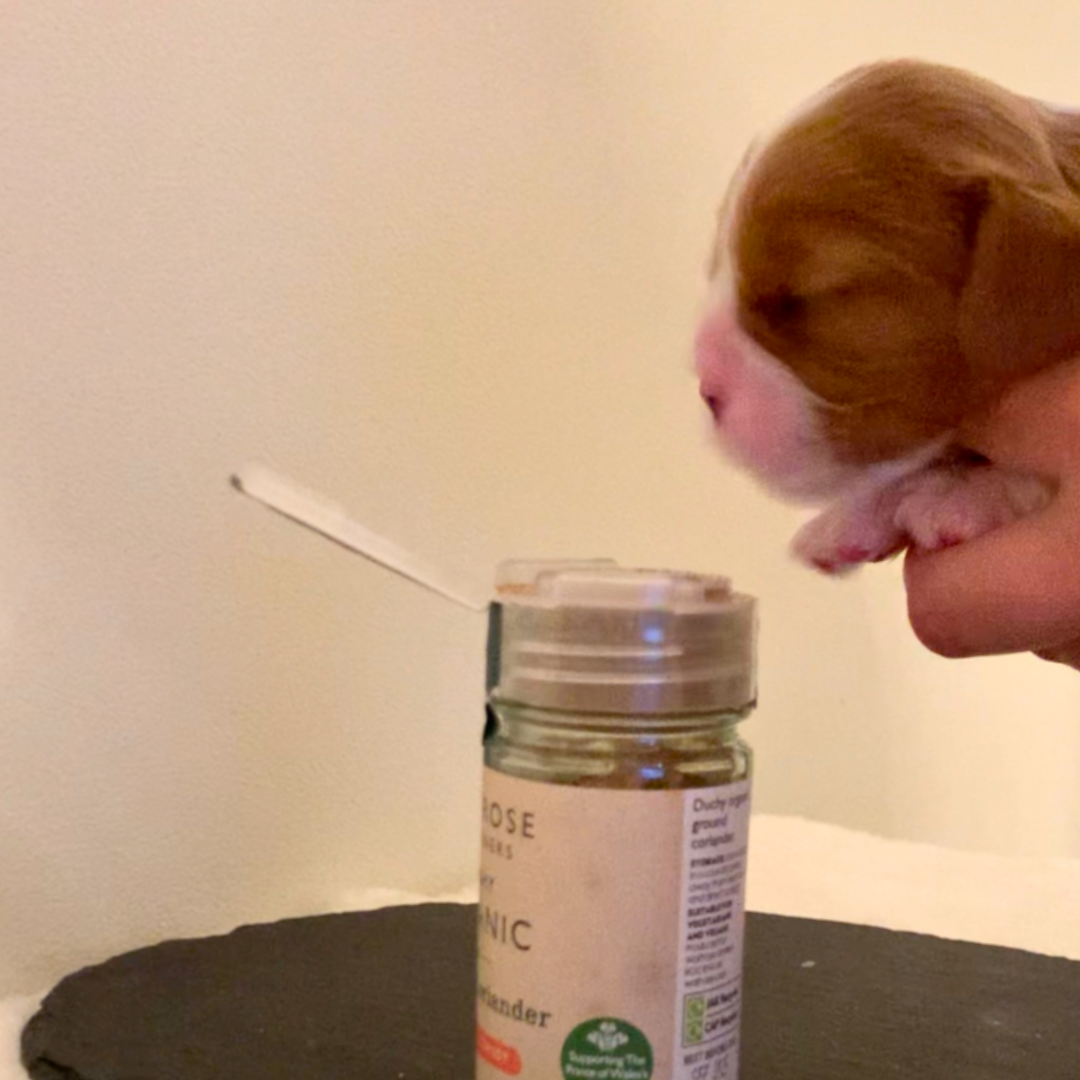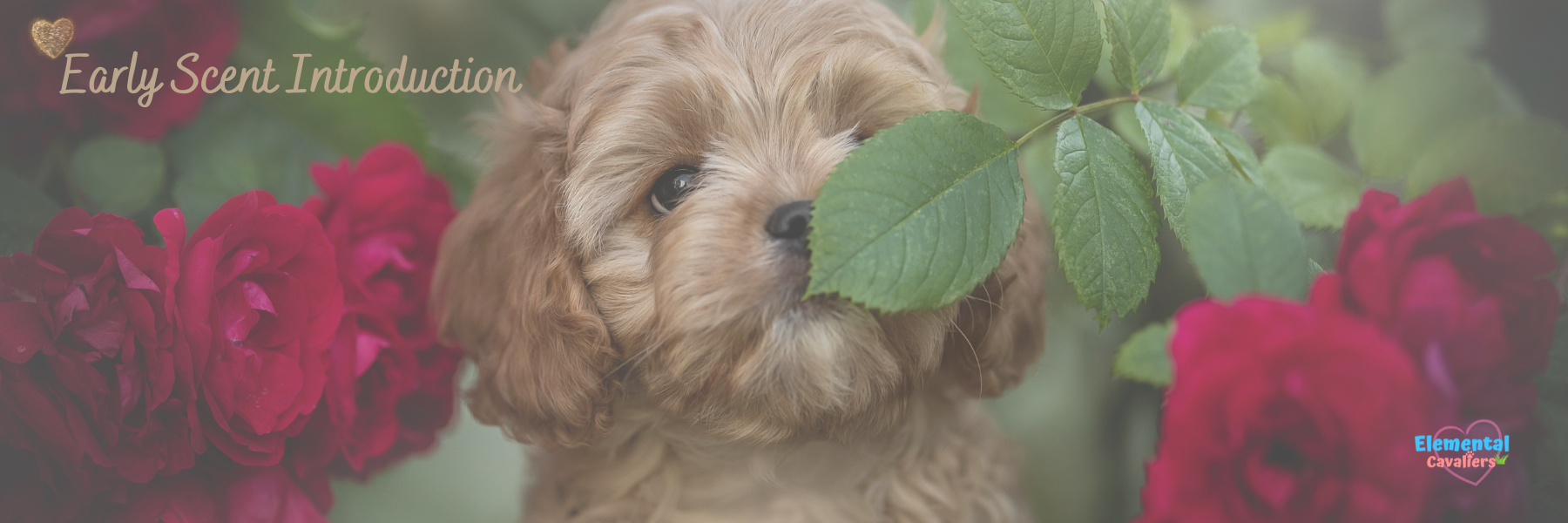Introduction
It is widely understood that dogs use their noses (their olfaction sense) as their primary sense. Humans on the other hand have their primary sense being our vision; using our eyes. We view the world through our eyes. Dogs, on the other hand smell the world using their noses. It is logical for us to work with the puppies to enhance all their senses, especially such an important one for them. Additional to Early Neurological Stimulation (ENS), we introduce our puppies to different scents that they wouldn’t find within their regular puppy environment.
What is Early Scent Introduction (ESI)
ESI enables the puppies to encounter and be curious about smells that they wouldn’t experience within their regular puppy environment. This process of smell introduction happens from the ages of 3 to 16 days old (the same time as we work with the puppies using ENS). Doctor Gayle Watson PhD designed the early scent introduction training for puppies through a breeding test spanning 7 years using Golden Retrievers in the United States.1 The puppies experience a new smell every day, for just 5 seconds initially, and we ensure they only smell the scent chosen and that their little noses don’t touch the item they are investigating. We only use natural scents, never chemical nor meat products. We use different selections for each litter of puppies, because the natural things from outdoors that we use can be seasonal. The herbs, spices and fruits, and dog training items that we use are often the same however. The scents often include: lemons, oranges, cinnamon, rosemary, mint and some of our dog training gear. The aim is to allow the puppies to encounter smells and get interested and slightly stimulated enough to potentially want to investigate; with the focus on scenting, not wanting to eat the smell!

Then, we log their reaction on their personal chart of learning. A positive reaction is when the puppy wishes to move closer and is actually interested in the scent, with active sniffing. If this happens, we allow them up to 30 seconds sniffing time. A negative reaction is when the puppy wants to move away; they often tend to turn their head away as an indicator of their wishes; in this instance we would stop the process for that puppy after the 5 seconds’ initial time. A neutral response is when puppy shows no reaction whatsoever, with no interest being shown. The time of day for scent work doesn’t happen together with ENS because we don’t wish to overstress the tiny puppies, nor for them to have an association between the scent being introduced and any stress, so we ensure they are fully rested between activities. It’s logical – similar to teaching anything really.
How Does Early Scent Introduction (ESI) Benefit a Puppy?
Neonate puppies (those that are very young & within the neonatal stage of their development – birth to 2 weeks old) are totally reliant on their Mum dog for food and cannot yet eliminate, so they need help with this also. This may seem like a period of time when nothing much is going on. But actually, the opposite is true. These first 2 weeks of their lives (yes fair enough the essential time for ENS and this ESI is up to 16 days old, so slightly older than 2 weeks) their brains are developing, and we may be able to use the neuroplasticity (the brain’s ability to change continuously) to improve their scent capabilities later in life. Introducing our puppies early to specific smells can actually enhance olfaction (with the greater the number of cells = the more enhanced) since it increases the numbers of cells of both olfactory bulb mitral and granule cells; this study reiterated findings from previous studies.2
This means that this can help to make dogs more aware of certain scents, and have improved scent capability, which is beneficial for any sort of service, therapy, & maybe even for companion dogs in general. Our adult dogs enjoy scent games, searching for items (& food) outside on walks and in the garden for example, and they are not used by us for therapy, but it heightens their everyday life, and capabilities for explorative play and search potential.
Since we focus on Cavaliers and Cavapoos, being companion breeds, they can make excellent therapy and assistance dogs later in life. Having enhanced scenting capabilities may help in many ways. We can introduce your puppy to specific ‘occupation’ scents should it be the case that your puppy will be likely to be used as a service dog, therapy dog, or assistance dog role later in their life. Please do let us know if this is the case when reserving your puppy & we can discuss which scents may be useful for puppy to make increased associations / recognitions with. When puppies are introduced to a scent during their neonatal age, they can identify and have an association with that scent, resulting in enhanced performance for rescue, search, field trails, obedience, and tracking. Puppies can also see improved confidence, increased optimism building and fewer behavioural issues; this is proved through research.3
Interestingly enough, during pregnancy of our adult girls, we ensure they eat a balanced diet, rich with the vital nutrients and fats needed at each stage. We continue giving a varied diet during Mum dog lactating in order to feed her puppies (& when Mum’s milk is no longer needed – but different nutrition is needed during pregnancy, whelping and lactation in order to build strong puppies & for the benefit of Mum dog). The reason this is interesting & how it ties in with scenting and ESI is that one study proved that dogs can actually recognise scent before they’re even born!4 Researchers wanted to study prenatal learning and how prenatal exposure to a stimulus (through the Mum’s food) can affect the puppies’ preferences during their neonatal stage (birth to 2 weeks old). They fed pregnant Mum dogs with anise-flavoured food during the last 3 weeks of pregnancy. 24 hours after birth, these puppies moved towards the anise smell but didn’t towards the smell of vanilla, which they hadn’t been introduced to during their time being in their Mum’s womb! We all know vanilla is a gorgeous smell so that’s incredible… This study also proves just how amazing dogs’ olfactory involvement is and the extent of their comprehension.
Wrap-up
We are passionate about assisting our puppies to turn into the dogs they should become. Whether this is for them to be able to develop into a companion at home, or a dog with a specific occupation, such as being a therapy dog, we want to help them get the most out of their intrinsically innate abilities, including their incredible sense of smell.
References
1. Watkins, G. Baby Noses – Introducing Scents to Neonate Puppies https://www.avidog.com/wp-content/uploads/2019/10/Avidog-Baby-Noses-Transcript.pdf
2. Rosselli-Austin, L. and Williams, J. (1990) ‘Enriched neonatal odor exposure leads to increased numbers of olfactory bulb mitral and granule cells’, Developmental Brain Research, 51(1), pp. 135 – 137 https://doi.org/10.1016/0165-3806(90)90267-3
3. Watkins, G. Early Scent Introduction for Neonate Puppies https://www.avidog.com/early-scent-introduction-for-neonate-puppies/
4. Hepper, P. G. and Wells, D. L. (2006) ‘Prenatal Olfactory Learning in the Domestic Dog’, Chemical Senses, 31(3), pp. 207 – 212. https://doi.org/10.1093/chemse/bjj020


